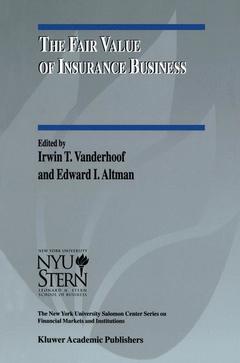Description
The Fair Value of Insurance Business, Softcover reprint of the original 1st ed. 2000
The New York University Salomon Center Series on Financial Markets and Institutions Series, Vol. 5
Language: English
Subjects for The Fair Value of Insurance Business:
Keywords
Financial Accounting; Hedging; accounting; cash flow; derivatives; insurance; liquidity; management; pricing; risk management; valuation
The Fair Value of Insurance Business
Publication date: 10-2012
322 p. · 15.5x23.5 cm · Paperback
Publication date: 10-2012
322 p. · 15.5x23.5 cm · Paperback
The fair value of insurance business
Publication date: 09-2000
322 p. · 15.5x23.5 cm · Hardback
Publication date: 09-2000
322 p. · 15.5x23.5 cm · Hardback
Description
/li>Contents
/li>
Insurance companies, as well as banks and thrift institutions, have traditionally reported assets and liabilities on the basis of their amortized cost, or book value. But following the turmoil in securities markets due to highly volatile interest rate fluctuations in the 1980s and the early 1990s, and problems caused by inadequate liquidity, in the mid-1990s the Financial Accounting Standards Board (FASB) issued a new ruling calling for financial intermediaries to report the fair, or market, value of most assets. Called FAS 115, this new standard is the first step in the eventual change to valuing all the assets and liabilities belonging to financial intermediaries under the fair value accounting method. Thus, these changes will pose tremendous future implications for three key business measures of a financial intermediary:
As the papers collected in The Fair Value of Insurance Business extend and update some of the issues treated in a previous Salomon Center conference volume, The Fair Value of Insurance Liabilities, this new volume may be viewed as a companion to the earlier book.
- Solvency: if the fair values of assets and liabilities are out-of-step, then healthy companies may report negative net worth and insolvent companies may appear to be in sound financial condition.
- Reported Earnings: if the fair values of assets and liabilities are out of step, then reported earnings will not accurately represent the financial operations of the company.
- Risk Management: FASB recently postponed the implementation of its new rules on accounting for the use of derivatives instruments. However, if the final set of rules for figuring the fair value of derivatives is not carefully crafted, it may be possible that companies prudently hedging their risks are subject to penalties in their financial reports, while companies taking greater risks appear to have less volatile financial performance.
As the papers collected in The Fair Value of Insurance Business extend and update some of the issues treated in a previous Salomon Center conference volume, The Fair Value of Insurance Liabilities, this new volume may be viewed as a companion to the earlier book.
I The Intellectual Underpinnings.- 1 Market Value of Insurance Liabilities and the Assumption of Perfect Markets in Valuation.- 2 The Valuation of Future Cash Flows: An Actuarial Issues Paper.- II Elaboration of Theory.- 3 Market Valuation of Liabilities: Transfer Pricing, Profit Release, and Credit Spread.- 4 Fair-Value Accounting for Financial Liabilities.- 5 Earnings, Historical-Cost Book Values, and Fair-Value Disclosures in the Valuation of Stock Life Insurance Companies.- III Illustrations of Fair-Value Calculations.- 6 Modeling Fair-Value Financial Reporting Results for the Single-Premium Deferred Annuity.- 7 Considerations for Ascertaining Term Insurance in a Fair-Value Con Context.- Contributors.
© 2024 LAVOISIER S.A.S.




